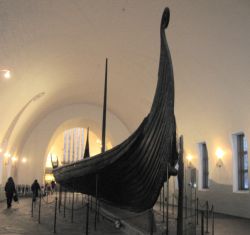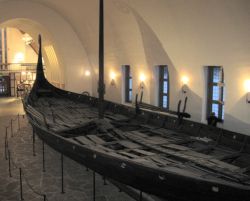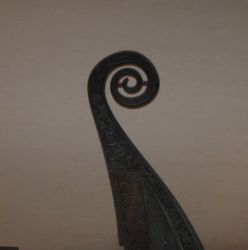 |
 |
||||
Viking TimeDecember 11, 2010 Growing up in New England you get the idea that as far as recorded history goes Harvard College, founded in 1636, is old. Houses built in the 18th century are old. Houses built in the 1930s are not. So Thursday evening (it wasn't five o'clock yet but it had been dark long enough that it seemed late) Kristin was explaining how there came to be two official Norwegian languages, Bokmål and Nynorsk, and why Bokmål looks like Danish but sounds like Swedish. When the Black Death hit Norway in the middle of 14th century, it wiped out about two thirds of the population. Priests and doctors were especially hard hit, and since they were overrepresented among the relatively small literate population, the written language pretty much disappeared. During the following centuries, Norway was ruled from Denmark, and Danish strongly influenced both the spoken language and, especially, the reconstituted written language. Someone told me that Danish sounds like Norwegian spoken with potatoes in one's mouth. ;-) Meanwhile, the spoken dialects of Norwegian continued to thrive, especially away from the urban centers (which tend to be in the south), and in the 19th century a linguist developed a combination of them, called Nynorsk although its origins are older than Bokmål. Now both dialects are official, and students learn both in school; each school chooses one for its primary language of instruction, and some 85 percent of all schools choose Bokmål. I can't remember the last time the Black Death came up as part of the explanation for current circumstances, and the Black Death hit Europe, including Norway, almost two hundred years before Harvard College was established by the Great and General Court of what eventually became the Commonwealth of Massachusetts. And the Norsemen went a-viking some six hundred years before that. I have stood next to ships built in the ninth century, at the Vikingskiphuset (Viking Ship Museum). The museum used to be a church. The nave and the two arms of the transept each house the hull of a ship. I just learned, or re-learned, that the word "nave" derives from the Latin navis, which means "ship." The ceiling of the nave mirrors the keel of a ship. It's true: it does. Is that why the Viking ships seem so at home in this former church? The plan is to eventually move the ships to another home closer to Oslo's center. The plan, I was told, is controversial: Will the ships, which look sturdy to the casual observer but are, truly, more than 1,100 years old, survive the journey? I wonder if their new home will provide a berth as snug as this one.
This is the Oseberg ship, so named for the place where it was found and excavated in 1904. It was built around 815–820 and sailed the Norwegian coast until it was used as the final resting place for a prominent woman who died in 834; buried with her were most valuable possessions and also, apparently, a serving woman. Thanks to the clay soil underneath and the mound of turf that was piled on top, these items survived the many centuries in remarkably good condition. A selection is displayed in what was once the church sanctuary: cart, sledge, small boats, home furnishings, tools and other implements, and even textiles. The Gokstad ship, on the left side of the transept, was likewise a burial site, this time of a prominent man, and his personal effects included a leather bridle ornamented with bronze. Leather from the ninth century! With its higher and sturdier sides, the Gokstad ship may have ventured further out on the open sea. Both ships could be rowed (by as many as 32 men) or sailed -- that's a mast in the middle, on which would have been raised a single square sail. Imagine if you will striking out from Scandinavia across the North Sea in such a ship, across the North Atlantic to Iceland, Greenland, Newfoundland, and maybe New England. The Vikings also sailed around western Europe, through the Straits of Gibraltar, and into the Mediterranean; they traded along the great rivers of Russia, all the way to the Black Sea. And they left their mark on Britain, too, where many place-names in the north of England have Scandinavian origins.
Here's a view of the Oseberg ship from above. We're not talking cabins here, or even berths.
I'm not a big souvenir buyer, but I couldn't resist a mug from the Viking museum. It's tall and graceful, wider at the top than the bottom, and an image of the Oseberg ship is wrapped around it. "Vikingskiphuset" is printed on the handle. I'm drinking my morning tea from it now.
|
|||||
Home - Writing - Editing - About Susanna - Bloggery - Articles - Poems - Contact Copyright ©
Susanna J. Sturgis. All rights reserved. |
|||||


